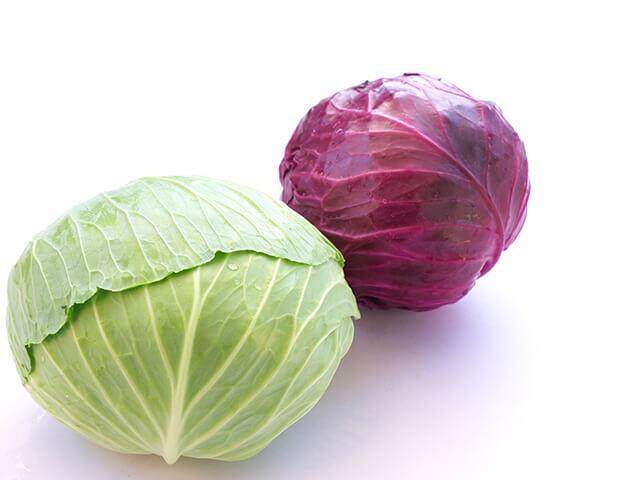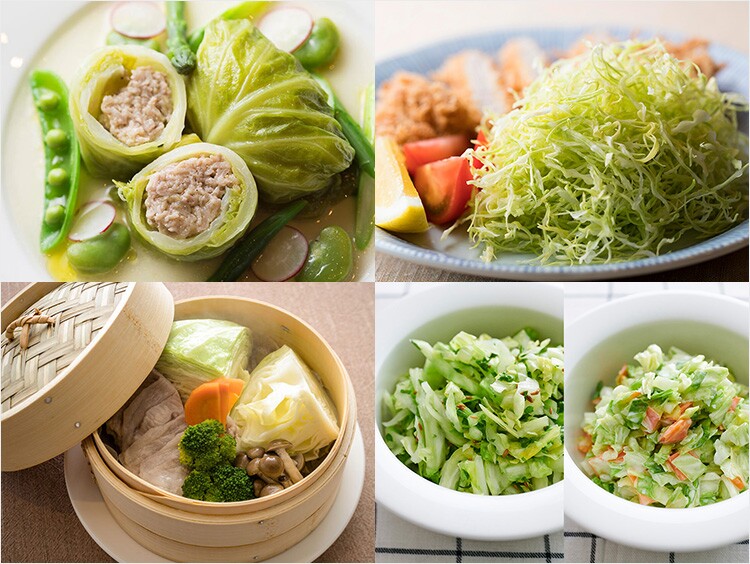In addition to green cabbage, there is also purple cabbage. Green cabbage typically costs between 25,000 and 35,000 VND per kg, while purple cabbage is priced higher at 50,000 to 55,000 VND per kg.
What are the nutritional benefits and effects of cabbage?
According to the United States National Nutrient Database, half a cup of cooked and chopped green cabbage (75g) contains only 22 calories but provides 54% of the vitamin C, 85% of vitamin K, 2g of fiber, and 1g of protein. It is also a good source of potassium, which can help lower high blood pressure.

Both purple and green cabbage are packed with nutrients that are beneficial to our health.
According to the National Institute of Nutrition (Ministry of Health), cabbage is a nutrient-dense food, rich in vitamins C, E, K, folate, magnesium, manganese, and carotenoids (lutein, zeaxanthin, and beta-carotene). It is also a great source of dietary fiber and antioxidants. Regular consumption of this vegetable not only provides essential nutrients but also helps lower blood pressure, improves digestion, reduces inflammation, promotes heart health, boosts the immune system, and may even prevent cancer.
Many people wonder which type of cabbage is better to consume and how to incorporate it into their diet properly.
Purple cabbage contains ten times more Vitamin A than green cabbage
According to B.S.CKI Nguyen Tran Nhu Thuy from Ho Chi Minh City University of Medicine and Pharmacy, cabbage is generally rich in vitamins A, C, and E. However, purple cabbage contains twice as much vitamin C and ten times more vitamin A than its green counterpart.
Dr. Thuy explains that the vitamins A and C, along with various antioxidants in purple cabbage, strengthen the immune system, protect the body from free radical damage, safeguard brain cells, prevent memory decline, promote healthy skin, combat aging, prevent liver spots, and enhance skin elasticity and softness.
Dr. Tu Ngu, Secretary-General of the Vietnam Nutrition Association, agrees that it is challenging to determine which vegetable is superior as it depends on individual needs and consumption quantities. Nonetheless, when it comes to fiber, vitamins, and mineral content, there are notable differences between the two.

Purple cabbage has a higher price tag and is less versatile in cooking compared to green cabbage.
According to Dr. Tu Ngu, in addition to its higher vitamin A content, purple cabbage also boasts higher levels of calcium, potassium, and vitamin C than green cabbage. These nutrients are particularly beneficial for the eyesight of both children and the elderly. Moreover, they contribute to a robust immune system, making it ideal for those recovering from illness.
Purple cabbage also contains more beta-carotene (a precursor of vitamin A) and exhibits superior antioxidant properties due to its ability to scavenge excess free radicals in the body. As a result, beta-carotene helps protect cell membranes, slows down aging, and may even prevent cancer.
Green cabbage is significantly higher in Vitamin K
Medical professionals advise that while green cabbage contains less vitamin A than purple cabbage, it boasts twice as much vitamin K. This essential vitamin plays a crucial role in blood clotting and preventing excessive bleeding.
Additionally, vitamin K in green cabbage contributes to strong bones by maintaining calcium density, thereby reducing the risk of osteoporosis and bone fractures.

Green cabbage is more affordable and versatile in the kitchen compared to purple cabbage.
Purple cabbage has a bitter taste, while green cabbage is sweeter
Dr. Tu Ngu points out that purple cabbage has a distinct bitter taste, making it suitable primarily for Vietnamese salad (“nộm”) or raw vegetable plates. Cooking methods such as boiling, stewing, or stir-frying may not yield desirable results. In contrast, green cabbage has a sweeter taste and can be used in a variety of dishes, including raw salads, soups, boiled or stir-fried dishes, and even grilled cabbage. Moreover, purple cabbage is more challenging to cultivate, resulting in higher prices, which may deter some consumers.
According to Dr. Tu Ngu, the choice of cabbage ultimately depends on individual preferences, taste, eating habits, and economic factors. The most important consideration is to ensure that the cabbage is thoroughly washed before consumption. It is advisable to cook cabbage before eating to prevent food poisoning and eliminate any potential microorganisms.
In terms of preparation, B.S.CKI Nguyen Tran Nhu Thuy recommends consuming purple cabbage raw to retain its nutritional value. If cooking, aim for a brief cooking time to avoid overcooking and nutrient loss. For those with digestive issues, it is advisable to avoid raw cabbage or salads as they may cause bloating and indigestion.




































